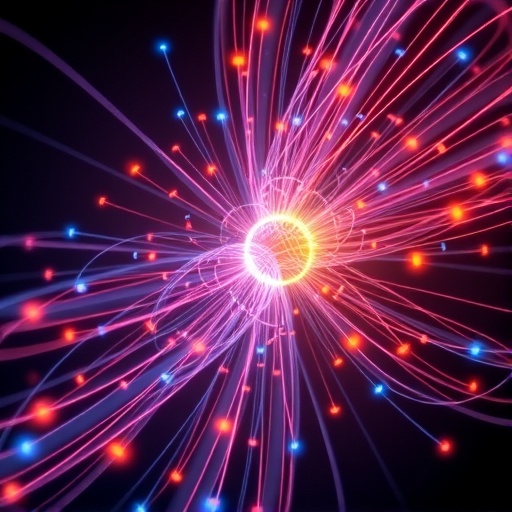In a groundbreaking advancement that challenges long-standing principles of thermodynamics, scientists from Japan have unveiled a novel method to harvest energy from waste heat with efficiency surpassing classical limits such as Carnot efficiency. This pioneering research leverages the exotic properties of a non-thermal Tomonaga-Luttinger liquid (TL liquid), a quantum state characterized by its resistance to thermal equilibrium. The approach signals transformative potential for sustainable, high-efficiency energy recovery systems, particularly in the realm of low-power electronics and quantum computing.
Traditional energy-harvesting technologies are hampered by fundamental thermodynamic constraints. Central to these limits is the Carnot efficiency, which defines the maximum theoretical efficiency for converting heat into work under conditions of thermal equilibrium. Moreover, the Curzon-Ahlborn efficiency accounts for real-world scenarios where power output is optimized but further caps achievable conversion rates. These boundaries have long hindered the practical maximization of usable energy extraction from waste heat—a ubiquitous byproduct in electronic circuits, industrial processes, and data centers.
Researchers, led by Professor Toshimasa Fujisawa from the Institute of Science Tokyo, sought to circumvent these thermodynamic ceilings by exploiting quantum phenomena manifest in one-dimensional electron systems. The Tomonaga-Luttinger liquid, a hallmark model describing electron interactions in constrained geometries, exhibits non-thermal behavior—retaining non-equilibrium distributions instead of dispersing energy evenly. This unique characteristic presents an opportunity to tap into high-energy, non-thermal electron states that conventional materials and devices inherently dissipate.
The research team devised an elegant experimental setup to test their theory. They introduced waste heat generated by a quantum point contact transistor into a TL liquid—a nanoscale system where electrons behave according to Luttinger liquid theory. This heat was carried along quantum channels over several micrometers without succumbing to thermalization. At the terminus of this pathway, the heat energized a quantum-dot heat engine, an ultrasmall device that leverages quantum confinement to efficiently convert heat into electrical power.
Remarkably, the measurements revealed substantially enhanced electrical voltages and improved energy conversion efficiencies compared to systems relying on quasi-thermalized heat sources. The non-thermal heat input retained its distinctive electron distribution functions during transport, a direct contrast to classical diffusive heat flow, enabling superior performance. This breakthrough underscores the TL liquid’s potential as a frontier medium for capturing and converting quantum heat energy beyond customary thermodynamic restrictions.
To deepen the understanding of their observations, the scientists formulated a theoretical model describing the electron energy distribution within the system. Employing a binary Fermi distribution, the model captured the peculiar non-thermal electron states and provided a framework explaining how these states facilitate conversion efficiencies exceeding both Carnot’s theoretical limit and the Curzon-Ahlborn efficiency for maximal power generation. This explanation emphasizes the foundational role of quantum statistical mechanics in redefining thermodynamic boundaries at the nanoscale.
The implications of this study are profound, transcending mere academic curiosity. Waste heat represents a vast, underutilized energy reservoir in modern technology ecosystems—from microprocessors in consumer electronics to large-scale quantum computers. Harnessing this otherwise lost energy stream using quantum-coherent states promises to dramatically enhance overall system efficiencies, reduce power consumption, and alleviate thermal management challenges that plague contemporary devices.
Furthermore, the utilization of TL liquids as a non-thermal energy resource introduces new design paradigms for quantum heat engines and thermoelectric devices. By preserving non-equilibrium electron distributions, such devices can capitalize on quantum correlations and interaction effects absent in classical frameworks. This could usher in a new class of quantum thermoelectric materials and components engineered explicitly for maximal waste heat recovery.
Professor Fujisawa notes that ongoing research will focus on integrating TL liquids with a variety of quantum devices and exploring scalability for practical implementations. The intersection of quantum information science and thermodynamics opens promising avenues for cryogenic electronics and energy-efficient quantum computing architectures, where heat dissipation remains a formidable obstacle.
Moreover, the experimental methodology combining quantum point contact heat sources, TL liquids, and quantum-dot heat engines provides a versatile platform for probing fundamental quantum thermodynamic principles. It also serves as a testbed for investigating nonequilibrium statistical mechanics in low-dimensional systems, potentially yielding insights applicable to broader nanotechnology and condensed matter physics domains.
This landmark study exemplifies the power of interdisciplinary collaboration, merging condensed matter physics, quantum electronics, and thermodynamics to challenge entrenched scientific dogmas. By demonstrating heat-energy conversion beyond classical efficiency limits, it not only advances fundamental knowledge but also catalyzes innovation in sustainable energy technologies.
In summary, the demonstration of efficient energy harvesting via non-thermal Tomonaga-Luttinger liquids not only transcends previous thermodynamic efficiency limitations but also heralds a future where quantum states empower revolutionary advances in energy sustainability. Harnessing these non-equilibrium quantum states optimally could redefine how we capture and utilize ambient energy, fueling the next generation of electronic and quantum devices with unprecedented efficiency and environmental responsibility.
Subject of Research: Not applicable
Article Title: Efficient heat-energy conversion from a non-thermal Tomonaga-Luttinger liquid
News Publication Date: 30-Sep-2025
Web References: https://doi.org/10.1038/s42005-025-02297-6
Image Credits: Institute of Science Tokyo (Science Tokyo)
Keywords: Energy harvesting, Electrical engineering, Engineering, Applied sciences and engineering, Physics, Environmental issues




